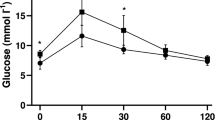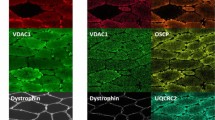Abstract
Within animal skeletal muscle, focal adhesion kinase (FAK) has been associated with load-dependent molecular and metabolic adaptation including the regulation of insulin sensitivity. This study aimed to generate the first visual images of the localisation of FAK within human skeletal muscle fibres and its associated microvasculature using widefield and confocal immunofluorescence microscopy. Percutaneous muscle biopsies, taken from five lean, active males, were frozen and 5-μm cryosections were incubated with FAK antibodies for visualisation in muscle fibres and the microvasculature. Anti-myosin heavy chain type I was used for fibre-type differentiation. Muscle sections were also incubated with anti-dihydropyridine receptor (DHPR) to investigate co-localisation of FAK with the t-tubules. FITC-conjugated Ulex europaeus Agglutinin I stained the endothelium of the capillaries, whilst anti-smooth muscle actin stained the vascular smooth muscle of arterioles. Fibre-type differences in the intensity of FAK immunofluorescence were determined with image analysis software. In transversely and longitudinally orientated fibres, FAK was localised at the sarcolemmal regions. In longitudinally orientated fibres, FAK staining also showed uniform striations across the fibre and co-staining with DHPR suggests FAK associates with the t-tubules. There was no fibre-type difference in sarcoplasmic FAK content. Within the capillary endothelium and arteriolar smooth muscle, FAK was distributed heterogeneously as clusters. This is the first study to visualise FAK in human skeletal muscle microvasculature and within the (sub)sarcolemmal and t-tubule regions using immunofluorescence microscopy. This technique will be an important tool for investigating the role of FAK in the intracellular signalling of human skeletal muscle and the endothelium of its associated microvasculature.






Similar content being viewed by others
References
Avraham HK, Lee TH, Koh Y, Kim TA, Jiang S, Sussman M, Samarel AM, Avraham S (2003) Vascular endothelial growth factor regulates focal adhesion assembly in human brain microvascular endothelial cells through activation of the focal adhesion kinase and related adhesion focal tyrosine kinase. J Biol Chem 278:36661–36668
Baar K, Esser K (1999) Phosphorylation of p70(S6k) correlates with increased skeletal muscle mass following resistance exercise. Am J Physiol 276:C120–C127
Baron V, Calleja V, Ferrari P, Alengrin F, Van Obberghen E (1998) p125Fak focal adhesion kinase is a substrate for the insulin and insulin-like growth factor-I tyrosine kinase receptors. J Biol Chem 273:7162–7168
Bergstrom J (1975) Percutaneous needle biopsy of skeletal muscle in physiological and clinical research. Scand J Clin Lab Invest 35:609–616
Bisht B, Dey CS (2008) Focal Adhesion Kinase contributes to insulin-induced actin reorganization into a mesh harboring Glucose transporter-4 in insulin resistant skeletal muscle cells. BMC Cell Biol 9:48
Bisht B, Goel HL, Dey CS (2007) Focal adhesion kinase regulates insulin resistance in skeletal muscle. Diabetologia 50:1058–1069
Bisht B, Srinivasan K, Dey CS (2008) In vivo inhibition of focal adhesion kinase causes insulin resistance. J Physiol 586:3825–3837
de Boer D, Ring C, Wood M, Ford C, Jessney N, McIntyre D, Carroll D (2007) Time course and mechanisms of mental stress-induced changes and their recovery: hematocrit, colloid osmotic pressure, whole blood viscosity, coagulation times, and hemodynamic activity. Psychophysiology 44:639–649
Durieux AC, D’ Antona G, Desplanches D, Freyssenet D, Klossner S, Bottinelli R, Fluck M (2009) Focal adhesion kinase is a load-dependent governor of the slow contractile and oxidative muscle phenotype. J Physiol 587:3703–3717
Ervasti JM (2003) Costameres: the Achilles’ heel of Herculean muscle. J Biol Chem 278:13591–13594
Fluck M, Carson JA, Gordon SE, Ziemiecki A, Booth FW (1999) Focal adhesion proteins FAK and paxillin increase in hypertrophied skeletal muscle. Am J Physiol 277:C152–C162
Fluck M, Ziemiecki A, Billeter R, Muntener M (2002) Fibre-type specific concentration of focal adhesion kinase at the sarcolemma: influence of fibre innervation and regeneration. J Exp Biol 205:2337–2348
Glover EI, Phillips SM, Oates BR, Tang JE, Tarnopolsky MA, Selby A, Smith K, Rennie MJ (2008) Immobilization induces anabolic resistance in human myofibrillar protein synthesis with low and high dose amino acid infusion. J Physiol 586:6049–6061
Goel HL, Dey CS (2002a) Focal adhesion kinase tyrosine phosphorylation is associated with myogenesis and modulated by insulin. Cell Prolif 35:131–142
Goel HL, Dey CS (2002b) Insulin stimulates spreading of skeletal muscle cells involving the activation of focal adhesion kinase, phosphatidylinositol 3-kinase and extracellular signal regulated kinases. J Cell Physiol 193:187–198
Gordon SE, Fluck M, Booth FW (2001) Selected contribution: skeletal muscle focal adhesion kinase, paxillin, and serum response factor are loading dependent. J Appl Physiol 90:1174–1183 (discussion 1165)
Huang D, Khoe M, Ilic D, Bryer-Ash M (2006) Reduced expression of focal adhesion kinase disrupts insulin action in skeletal muscle cells. Endocrinology 147:3333–3343
Ilic D, Kovacic B, McDonagh S, Jin F, Baumbusch C, Gardner DG, Damsky CH (2003) Focal adhesion kinase is required for blood vessel morphogenesis. Circ Res 92:300–307
Ishida T, Peterson TE, Kovach NL, Berk BC (1996) MAP kinase activation by flow in endothelial cells. Role of beta 1 integrins and tyrosine kinases. Circ Res 79:310–316
Karlsson HK, Zierath JR (2007) Insulin signaling and glucose transport in insulin resistant human skeletal muscle. Cell Biochem Biophys 48:103–113
Klossner S, Durieux AC, Freyssenet D, Flueck M (2009) Mechano-transduction to muscle protein synthesis is modulated by FAK. Eur J Appl Physiol 106:389–398
Knight JB, Yamauchi K, Pessin JE (1995) Divergent insulin and platelet-derived growth factor regulation of focal adhesion kinase (pp 125FAK) tyrosine phosphorylation, and rearrangement of actin stress fibers. J Biol Chem 270:10199–10203
Lauritzen HP, Ploug T, Prats C, Tavare JM, Galbo H (2006) Imaging of insulin signaling in skeletal muscle of living mice shows major role of t-tubules. Diabetes 55:1300–1306
Lauritzen HP, Galbo H, Brandauer J, Goodyear LJ, Ploug T (2008a) Large GLUT4 vesicles are stationary while locally and reversibly depleted during transient insulin stimulation of skeletal muscle of living mice: imaging analysis of GLUT4-enhanced green fluorescent protein vesicle dynamics. Diabetes 57:315–324
Lauritzen HP, Ploug T, Ai H, Donsmark M, Prats C, Galbo H (2008b) Denervation and high-fat diet reduce insulin signaling in t-tubules in skeletal muscle of living mice. Diabetes 57:13–23
Lebrun P, Mothe-Satney I, Delahaye L, Van Obberghen E, Baron V (1998) Insulin receptor substrate-1 as a signaling molecule for focal adhesion kinase pp125(FAK) and pp60(src). J Biol Chem 273:32244–32253
Li S, Kim M, Hu YL, Jalali S, Schlaepfer DD, Hunter T, Chien S, Shyy JY (1997) Fluid shear stress activation of focal adhesion kinase. Linking to mitogen-activated protein kinases. J Biol Chem 272:30455–30462
Mikines KJ, Sonne B, Farrell PA, Tronier B, Galbo H (1988) Effect of physical exercise on sensitivity and responsiveness to insulin in humans. Am J Physiol 254:E248–E259
Narici MV, Flueck M, Koesters A, Gimpl M, Reifberger A, Seynnes OR, Niebauer J, Rittweger J, Mueller E (2011) Skeletal muscle remodeling in response to alpine skiing training in older individuals. Scand J Med Sci Sports 21(Suppl 1):23–28
Pardo JV, Siliciano JD, Craig SW (1983) A vinculin-containing cortical lattice in skeletal muscle: transverse lattice elements (“costameres”) mark sites of attachment between myofibrils and sarcolemma. Proc Natl Acad Sci USA 80:1008–1012
Peng X, Ueda H, Zhou H, Stokol T, Shen TL, Alcaraz A, Nagy T, Vassalli JD, Guan JL (2004) Overexpression of focal adhesion kinase in vascular endothelial cells promotes angiogenesis in transgenic mice. Cardiovasc Res 64:421–430
Perseghin G, Price TB, Petersen KF, Roden M, Cline GW, Gerow K, Rothman DL, Shulman GI (1996) Increased glucose transport-phosphorylation and muscle glycogen synthesis after exercise training in insulin-resistant subjects. N Engl J Med 335:1357–1362
Ploug T, van Deurs B, Ai H, Cushman SW, Ralston E (1998) Analysis of GLUT4 distribution in whole skeletal muscle fibers: identification of distinct storage compartments that are recruited by insulin and muscle contractions. J Cell Biol 142:1429–1446
Quach NL, Rando TA (2006) Focal adhesion kinase is essential for costamerogenesis in cultured skeletal muscle cells. Dev Biol 293:38–52
Schlaepfer DD, Hauck CR, Sieg DJ (1999) Signaling through focal adhesion kinase. Prog Biophys Mol Biol 71:435–478
Shen TL, Park AY, Alcaraz A, Peng X, Jang I, Koni P, Flavell RA, Gu H, Guan JL (2005) Conditional knockout of focal adhesion kinase in endothelial cells reveals its role in angiogenesis and vascular development in late embryogenesis. J Cell Biol 169:941–952
Shikata Y, Birukov KG, Garcia JG (2003) S1P induces FA remodeling in human pulmonary endothelial cells: role of Rac, GIT1, FAK, and paxillin. J Appl Physiol 94:1193–1203
Tong P, Khayat ZA, Huang C, Patel N, Ueyama A, Klip A (2001) Insulin-induced cortical actin remodeling promotes GLUT4 insertion at muscle cell membrane ruffles. J Clin Invest 108:371–381
Wang W, Hansen PA, Marshall BA, Holloszy JO, Mueckler M (1996) Insulin unmasks a COOH-terminal Glut4 epitope and increases glucose transport across t-tubules in skeletal muscle. J Cell Biol 135:415–430
Wang Y, Flores L, Lu S, Miao H, Li YS, Chien S (2009) Shear stress regulates the Flk-1/Cbl/PI3K/NF-kappaB pathway via actin and tyrosine kinases. Cell Mol Bioeng 2:341–350
Wilkinson SB, Phillips SM, Atherton PJ, Patel R, Yarasheski KE, Tarnopolsky MA, Rennie MJ (2008) Differential effects of resistance and endurance exercise in the fed state on signalling molecule phosphorylation and protein synthesis in human muscle. J Physiol 586:3701–3717
Wu X, Davis GE, Meininger GA, Wilson E, Davis MJ (2001) Regulation of the L-type calcium channel by alpha 5beta 1 integrin requires signaling between focal adhesion proteins. J Biol Chem 276:30285–30292
Wu MH, Guo M, Yuan SY, Granger HJ (2003) Focal adhesion kinase mediates porcine venular hyperpermeability elicited by vascular endothelial growth factor. J Physiol 552:691–699
Zeng G, Nystrom FH, Ravichandran LV, Cong LN, Kirby M, Mostowski H, Quon MJ (2000) Roles for insulin receptor, PI3-kinase, and Akt in insulin-signaling pathways related to production of nitric oxide in human vascular endothelial cells. Circulation 101:1539–1545
Acknowledgments
The antibodies against human slow myosin (A4.840-c) used in the study were developed by Dr. Blau and were obtained from the Developmental Studies Hybridoma Bank developed under the auspices of the NICHD and maintained by The University of Iowa, Department of Biological Sciences, Iowa City, IA 52242. OJW is funded by a BBSRC targeted priority studentship into ageing.
Author information
Authors and Affiliations
Corresponding author
Rights and permissions
About this article
Cite this article
Wilson, O.J., Shaw, C.S., Sherlock, M. et al. Immunofluorescent visualisation of focal adhesion kinase in human skeletal muscle and its associated microvasculature. Histochem Cell Biol 138, 617–626 (2012). https://doi.org/10.1007/s00418-012-0980-x
Accepted:
Published:
Issue Date:
DOI: https://doi.org/10.1007/s00418-012-0980-x




